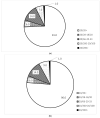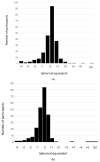Refractive Error and Axial Length and Their Related Factors in 8-Year-Old Japanese Children: The Yamanashi Adjunct Study of the Japan Environment and Children's Study (JECS)
- PMID: 37762870
- PMCID: PMC10532322
- DOI: 10.3390/jcm12185929
Refractive Error and Axial Length and Their Related Factors in 8-Year-Old Japanese Children: The Yamanashi Adjunct Study of the Japan Environment and Children's Study (JECS)
Abstract
Purpose: To investigate the distribution of visual acuity, refractive error, and axial length in 8-year-old children who participated in an additional survey in Yamanashi Prefecture of the Japan Environmental Children's Study (hereafter referred to as JECS-Y) conducted from 2019 to 2021.
Participants and methods: Eight-year-old children who participated in the JECS-Y study were subjected to noncycloplegic measurements of refractive error and axial length. If the uncorrected visual acuity was less than 20/20, the best corrected visual acuity was evaluated in accordance with the autorefraction data. A questionnaire was administered regarding the parent's history of eyeglass wear or contact lens use.
Results: Among the 400 participating children, the rate of uncorrected visual acuity of 20/20 or better in both eyes was 70.4%. The mean equivalent spherical equivalent error for both eyes was -0.366 ± 1.016 D. The mean axial length was 23.08 ± 0.225 mm in all patients. The males showed significantly longer axial length than the females despite no differences in body height. There was a significant correlation between axial length, spherical refractive, and uncorrected visual acuity. The children of parents with a history of wearing eyeglasses or contact lenses showed a significantly more myopic equivalent refractive error than those without a history.
Conclusions: This study clarified the current state of refractive error in 8-year-old children and the association of inheritance with refractive error. In addition, the axials were significantly longer in male patients.
Keywords: axial length; children; refractive error.
Conflict of interest statement
The authors declare no conflict of interest.
Figures










Similar articles
-
Phakic intraocular lenses for the treatment of refractive errors: an evidence-based analysis.Ont Health Technol Assess Ser. 2009;9(14):1-120. Epub 2009 Oct 1. Ont Health Technol Assess Ser. 2009. PMID: 23074518 Free PMC article.
-
The child self-refraction study results from urban Chinese children in Guangzhou.Ophthalmology. 2011 Jun;118(6):1162-9. doi: 10.1016/j.ophtha.2010.10.003. Epub 2011 Jan 12. Ophthalmology. 2011. PMID: 21232802 Free PMC article.
-
Role of parental myopia in the progression of myopia and its interaction with treatment in COMET children.Invest Ophthalmol Vis Sci. 2007 Feb;48(2):562-70. doi: 10.1167/iovs.06-0408. Invest Ophthalmol Vis Sci. 2007. PMID: 17251451
-
Vision screening for correctable visual acuity deficits in school-age children and adolescents.Cochrane Database Syst Rev. 2018 Feb 15;2(2):CD005023. doi: 10.1002/14651858.CD005023.pub3. Cochrane Database Syst Rev. 2018. PMID: 29446439 Free PMC article. Review.
-
Optical correction of refractive error for preventing and treating eye symptoms in computer users.Cochrane Database Syst Rev. 2018 Apr 10;4(4):CD009877. doi: 10.1002/14651858.CD009877.pub2. Cochrane Database Syst Rev. 2018. PMID: 29633784 Free PMC article. Review.
Cited by
-
[Management of ANCA-associated vasculitides].Inn Med (Heidelb). 2024 Feb;65(2):93-106. doi: 10.1007/s00108-023-01655-2. Epub 2024 Jan 22. Inn Med (Heidelb). 2024. PMID: 38253699 Review. German.
References
-
- Michikawa T., Nitta H., Nakayama S.F., Ono M., Yonemoto J., Tamura K., Suda E., Ito H., Takeuchi A., Kawamoto T. The Japan Environment and Children’s Study (JECS): A Preliminary Report on Selected Characteristics of Approximately 10 000 Pregnant Women Recruited During the First Year of the Study. J. Epidemiol. 2015;25:452–458. doi: 10.2188/jea.JE20140186. - DOI - PMC - PubMed
Grants and funding
LinkOut - more resources
Full Text Sources

